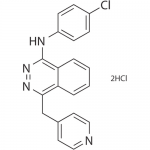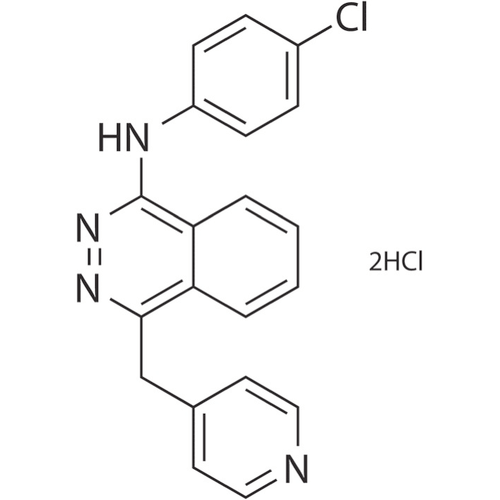| Product Name | Vatalanib Dihydrochloride |
| Description |
VEGFR Tyrosine Kinase Inhibitor |
| Purity | 96% |
| CAS No. | 212141-51-0 |
| Molecular Formula | C20H17Cl3N4 |
| Molecular Weight | 419.7 |
| Field of Use | Not for use in humans. Not for use in diagnostics or therapeutics. For in vitro research use only. |
Properties
| Storage Temperature | -20ºC |
| Shipping Temperature | Shipped Ambient |
| Product Type | Inhibitor |
| Solubility | Soluble in DMSO (30 mg/ml), ethanol (10 mg/ml) with warming; very poorly soluble in water; maximum solubility in plain water is estimated to be about 10-20 µM; buffers, serum, or other additives may increase or decrease the aqueous solubility.Also soluble in methanol, and water ( ≥10 mg/ml ) |
| Source | Synthetic |
| Appearance | Solid |
| SMILES | C1=CC=C2C(=C1)C(=NN=C2NC3=CC=C(C=C3)Cl)CC4=CC=NC=C4.Cl.Cl |
| InChI | InChI=1S/C20H15ClN4.2ClH/c21-15-5-7-16(8-6-15)23-20-18-4-2-1-3-17(18)19(24-25-20)13-14-9-11-22-12-10-14;;/h1-12H,13H2,(H,23,25);2*1H |
| InChIKey | AZUQEHCMDUSRLH-UHFFFAOYSA-N |
| Safety Phrases |
Classification: Not a hazardous substance or mixture. Safety Phrases: S22 - Do not breathe dust. S24/25 - Avoid contact with skin and eyes. S36/37/39 - Wear suitable protective clothing, gloves and eye/face protection. |
| Cite This Product | Vatalanib Dihydrochloride (StressMarq Biosciences Inc., Victoria BC CANADA, Catalog # SIH-484) |
Biological Description
| Alternative Names | N-(4-Chlorophenyl)-4-(4-pyridinylmethyl)-1-phthalazinamine dihydrochloride |
| Research Areas | Apoptosis, Cancer, Cancer Growth Inhibitors, Cardiovascular System, Cell Signaling, Growth Factor Receptor Inhibitors |
| PubChem ID | 22386467 |
| Scientific Background | Vatalanib Dihydrochloride is an inhibitor of Flk, c-Kit, and PDGFR-β, with demonstrated activity against VEGFR-dependent angiogenesis and EGFR- and RET-mediated tumor cell proliferation. In neuroscience, Vatalanib is used to explore the role of angiogenic and growth factor signaling in neurodegenerative diseases. Its ability to modulate vascular and glial responses makes it a useful tool for studying neuroinflammation, blood-brain barrier dysfunction, and tumor progression in the CNS. |
| References | 1. Herbst R.S., Heymach J.V., O’Reilly M. S., Onn A., & Ryan A.J. (2007) Expert Opin. Invest. Drugs. 16(2): 239–249. |



Reviews
There are no reviews yet.